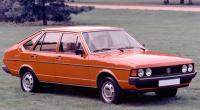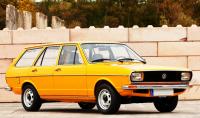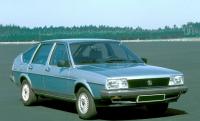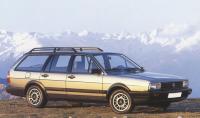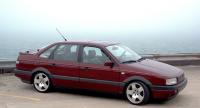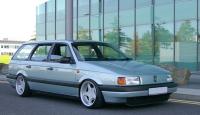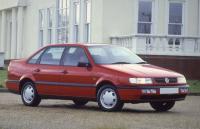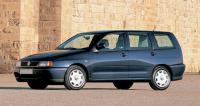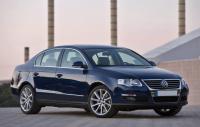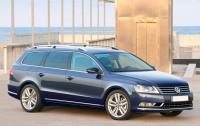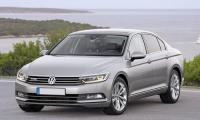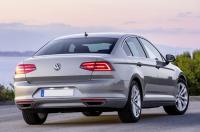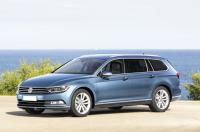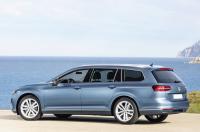Passat B1 (1973—1980)
The first generation was introduced in May 1973, was produced for 7 years, and until 1980 2.6 million cars were produced. In addition to Germany, B1s were produced in Brazil (before 1988), Australia, South Africa and Nigeria. The bodies were of four types - 2 and 4 door sedans and 3 and 5 door hatchbacks. Another body type - station wagon - appeared in 1974.
The power plant was not very diverse - three four-cylinder gasoline engines with a volume of 1.3, 1.5 and 1.6 liters (55, 75 and 85 hp) and one diesel for 1.5 liters (50 hp). In 1979, the 1.6 GLI fuel injected engine with 110 hp appeared. Transmission 4-speed manual or 3-speed automatic. All cars were front-wheel drive.
This modification has been awarded «car of the year» by Wheels magazine in 1974. In 1977, they made a restyling, the exterior of the front end was mainly changed, as well as the taillights. Both metal bumpers were replaced with plastic ones.
Passat B2 (1980—1988)
The second generation was introduced in October 1980. For eight years, more than 4 million cars were produced in Germany and other countries. In addition to Germany, the car was also assembled in Brazil, Spain, Argentina, Mexico, South Africa and China. The main changes are the new design, which no longer allowed to compare the car with the Audi 80, as well as a noticeable increase in size. Initially, there were 3 body types - 3 and 5-door hatchback and station wagon. In 1981, a four-door sedan appeared - the Volkswagen Santana.
The range of engines has greatly expanded compared to the first generation. There were 8 modifications of petrol: 1.3, 1.5, 1.6, 1.8, 2.0 liters (L4) and 1.9, 2.0, 2.2 liters (L5) power from 72 to 174 hp, and only 3 diesel modifications: 1.5 LD4, 1.6 LTD4, 1.9 LD4 with power from 68 to 80 hp. There are only 3 types of transmissions - 4-speed and 5-speed manual transmission and 4-speed automatic transmission with front-wheel drive. In 1984, the first Passat Synchro with all-wheel drive appeared.
Since 1984, the Japanese company Nissan has been assembling the Santana sedan. In 1985, the Passat was restyled. The first engines with catalytic converters appeared. Also this year, Santana began to be produced in China. The production of this model in China was completed only in 2013 and over 3 million cars were assembled in almost 28 years.
Passat B3 (1988—1993)
This generation was introduced in 1988 in Europe, North America (1990) and in South America (1995). The demand for the car was very high due to the modern appearance, spacious interior and luggage compartment. The body is executed in two versions - sedan and station wagon.
The car on the European market was represented by different trim levels: CL (Classic), basic with some options; GL (Grand Lux), richer, with the same body color, bumpers and mirrors, any options are available; GT (Grand Turismo), sports equipment with an injection engine, a plastic body kit, sports seats and also any options to choose from; GLX for America, the richest with any options.
Power plants are represented by gasoline engines with a volume of 1.6 to 2.8 liters (72-211 hp), as well as diesel engines from 1.6 to 1.9 liters (68-80 hp). Transmission 5-speed manual and 4-speed automatic transmission with front-wheel drive, and cars with the designation Synchro have all-wheel drive.
Passat B4 (1993—1997)
The fourth generation is a deep restyling of the previous modification. The radiator grille reappeared, the design of the car interior changed. The body is also in two versions - sedan and station wagon.
Engine range includes 1.6, 1.8 and 2.0 L4 petrols, 2.8 and 2.9 liter V6s (100-184 hp), as well as diesel engines with a volume of 1.9 liters (75-110 hp). Transmission 5-speed manual transmission and 4-speed automatic transmission with front-wheel drive, all-wheel drive models have the Synchro prefix.
Cars of this generation were produced about 690 thousand units.
Passat B5 (1996—2005)
Cars of this generation are fundamentally different from the previous one. They are unified with the brand Audi A4 and Audi A6. Over the almost 10-year release period, the B5 has become truly popular, with about 3.3 million units collected in total. Body types remained unchanged - sedan and station wagon.
Engines installed gasoline L4: 1.6, 1.8 and 2.0 liters, V5 2.3 liters, V6 2.8 liters (90-193 hp) and W8 4.0 liters (275 hp); as well as diesel engines with a volume of 1.9-2.5 liters (45-150 hp). Three types of transmission: 5 and 6-speed manual transmission and 5-speed automatic transmission. The drive is also mainly on the front wheels, all-wheel drive models have the Synchro prefix.
Facelifted in 2001 and "new" name - Passat B5 + or B5.5. A number of improvements were made, equipment upgrades and changes in the appearance of the car.
Passat B6 (2005—2010)
In 2005, the sixth generation of the Passat was presented at the Geneva Motor Show. The most important difference from the models of previous years is the transverse arrangement of the engine under the hood. Body types have not changed - sedan and station wagon.
The range of engines includes gasoline, from 1.4 to 3.2 liters (122-250 hp) and diesel, from 1.6 to 2.0 liters (105-170 hp). The choice of transmissions has expanded significantly: 5 and 6-speed manual transmissions, 6-speed automatic transmissions, as well as 6 and 7-speed DSG robotic preselective gearboxes.
Passat B7 (2010—2014)
This generation is essentially a restyling of the sixth generation. This mainly affected the appearance of the car, but the interior remained almost the same. New electronic systems have appeared - shock absorber control, automatic braking and automatic parking. Body types - sedan and station wagon.
Aspirated engines have completely disappeared from the engines, replaced by turbocharging. Four petrol engines ranging from 1.4 to 2.0 liters (122-211 hp) and one 2.0 liter turbodiesel (170 hp). The choice of transmission consists of three options: 6-speed manual transmission, 6-speed and 7-speed robotic DSG.
Passat B8 (2014—present)
In November 2014, the eighth modification of the Passat appeared in Europe. It is based on a new elongated MQB platform (modular vehicle platform with a transverse front engine). Aluminum and steel are used to reduce weight.
It uses a large number of driver assistance systems, such as semi-automatic parking, emergency assistant, autonomous cruise control system, collision avoidance system, progressive steering and more.
The range of engines is represented by gasoline, from 1.4 to 2.0 liters (125-211 hp) and diesel, with a volume of 2.0 liters (170 hp). The transmission is the same as the generation B7.

